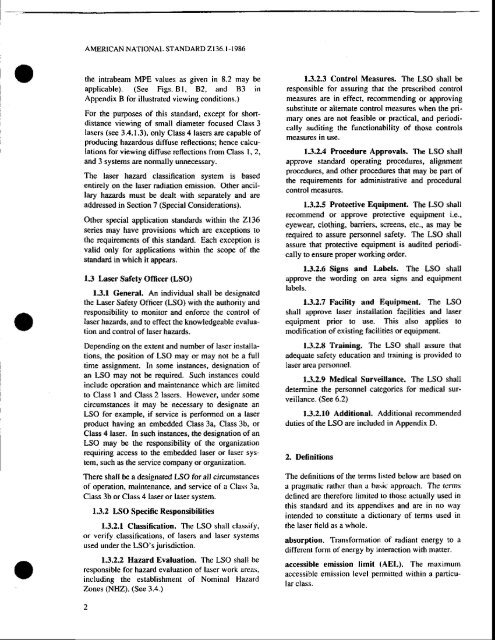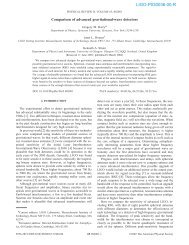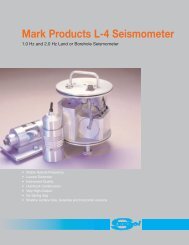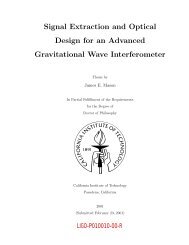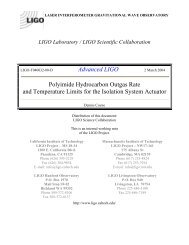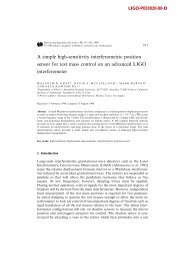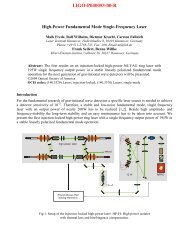for the sqfe use of lqsers - LIGO
for the sqfe use of lqsers - LIGO
for the sqfe use of lqsers - LIGO
You also want an ePaper? Increase the reach of your titles
YUMPU automatically turns print PDFs into web optimized ePapers that Google loves.
o<br />
AMERICAN NATIONAL STANDARD ZI36.I-I986<br />
<strong>the</strong> intrabeam MPE values as given in 8.2 may be<br />
applicable). (See Figs. Bl, 82, and 83 in<br />
Appendix B <strong>for</strong> illustrated viewing conditions-)<br />
For <strong>the</strong> purposes <strong>of</strong> this standard, except <strong>for</strong> shortdistance<br />
viewing <strong>of</strong> small diameter foc<strong>use</strong>d Class 3<br />
lasers (see 3.4.1.3), only Class 4 lasers are capable <strong>of</strong><br />
producing hazardous diff<strong>use</strong> reflections; hence calculations<br />
<strong>for</strong> viewing diff<strong>use</strong> reflections from Class l, 2,<br />
and 3 systems are normally unnecessary.<br />
The laser hazard classification system is based<br />
entirely on <strong>the</strong> laser radiation emission. O<strong>the</strong>r ancillary<br />
hazards must be dealt with separately and are<br />
addressed in Section 7 (Special Considerations).<br />
O<strong>the</strong>r special application standards within <strong>the</strong> 2136<br />
series may have provisions which are exceptions to<br />
<strong>the</strong> requirements <strong>of</strong> this standard. Each exception is<br />
valid only <strong>for</strong> applications within <strong>the</strong> scope <strong>of</strong> <strong>the</strong><br />
standard in which it appears.<br />
1.3 Laser Safety Officer (LSO)<br />
1.3.1 General, An individual shall be designated<br />
<strong>the</strong> Laser Safety Officer (LSO) with <strong>the</strong> authority and<br />
responsibility to monitor and en<strong>for</strong>ce <strong>the</strong> control <strong>of</strong><br />
laser hazards, and to effect <strong>the</strong> knowledgeable evalua-<br />
(ion and control <strong>of</strong> laser hazards.<br />
Depending on <strong>the</strong> extent and numb€r <strong>of</strong> laser installations,<br />
<strong>the</strong> position <strong>of</strong> LSO may or may not be a full<br />
time assignment. In some instances, designation <strong>of</strong><br />
an LSO may not be required. Such instances could<br />
include operation and maintenance which are limited<br />
to Class I and Class 2 lasers. However, under some<br />
circumstances it may be necessary to designate an<br />
LSO <strong>for</strong> example, if service is per<strong>for</strong>med on a laser<br />
product having an embedded Class 3a, Class 3b, or<br />
Class 4laser. In such iostances, <strong>the</strong> designation <strong>of</strong>an<br />
LSO may be <strong>the</strong> responsibility <strong>of</strong> <strong>the</strong> organization<br />
requiring access to <strong>the</strong> embedded laser or laser system,<br />
such as <strong>the</strong> service company or organization.<br />
There shall be a designated LSO <strong>for</strong> all circumstances<br />
<strong>of</strong> operation, maintenance, and service <strong>of</strong> a Class 3a,<br />
Class 3b or Class 4 laser or laser system.<br />
1.3,2 LSO Specific Responsibililies<br />
13.2.1 Classification. The LSO shall classily,<br />
or verify classifications, <strong>of</strong> lasers and laser systems<br />
<strong>use</strong>d under <strong>the</strong> LSO's jurisdiction.<br />
1.3,2.2 Hnard Evaluation. The LSO shall be<br />
responsible <strong>for</strong> hazard evaluation <strong>of</strong> laser work areas,<br />
including <strong>the</strong> establishment <strong>of</strong> Nominal Hazard<br />
Zones (NHZ). (See 3.4.)<br />
2<br />
1.3.2.3 Control Measures. The LSO shall be<br />
responsible <strong>for</strong> assuring that <strong>the</strong> prescribed control<br />
measures are in effect, recommending or approving<br />
substitute or altemate control measures when <strong>the</strong> primary<br />
ones are not feasible or practical, and periodically<br />
auditing <strong>the</strong> functionability <strong>of</strong> those controls<br />
measures in <strong>use</strong>.<br />
13.2.4 Procedure Approvals, The LSO shall<br />
approve standard operating procedures, alignment<br />
procedures, and o<strong>the</strong>r procedures that may be part <strong>of</strong><br />
<strong>the</strong> requirements <strong>for</strong> administrative and procedural<br />
control measures.<br />
1,3.2.5 Protective Equipment. The LSO shall<br />
recommend or approve protective equipment i.e.,<br />
eyewear, clothing, barriers, scrcens, etc., as may be<br />
required to assure personnel safety. The LSO shall<br />
assure that protective equipment is audited periodically<br />
to ensure proper working order.<br />
1,3.2.6 Signs and Labels. The LSO shall<br />
approve <strong>the</strong> wording on area signs and equipment<br />
labels.<br />
1.3.2.7 Facility and Equipment. The LSO<br />
shall approve laser installation facilities aod laser<br />
equipment prior to <strong>use</strong>. This also applies to<br />
modification <strong>of</strong> existing facilities or equipment.<br />
1.3.2.8 Training, The LSO shall assur€ that<br />
adequae safety education and training is provided to<br />
laser area penionnel.<br />
1.3.2.9 Medical Surveillance. The LSO shall<br />
determine <strong>the</strong> personnel categories <strong>for</strong> medical surveillance.<br />
(See 6.2)<br />
1.3,2.10 Additional. Additional recommended<br />
duties <strong>of</strong> <strong>the</strong> LSO are included in Appendix D.<br />
2. Definitions<br />
The definitions <strong>of</strong> <strong>the</strong> lerms listed below are based on<br />
r pragmatic rathor than u basic approach. The tcrms<br />
delined are <strong>the</strong>re<strong>for</strong>e limited to those actually <strong>use</strong>d in<br />
this standard and its appendixes and are in no way<br />
intended to constitute a dictionary <strong>of</strong> terms <strong>use</strong>d in<br />
<strong>the</strong> laser lield as a whole.<br />
absorption. Trans<strong>for</strong>mation <strong>of</strong> radiant energy to a<br />
differenr <strong>for</strong>m <strong>of</strong>energy by interaction with matter.<br />
accessible emission limit (AEL). The maximum<br />
accessible emission level p€rmined wiftin a particular<br />
class.


